As Good As It Gets
By Jordan Rane
Photographs by Vince Heptig
More than 1,000 Arrowmen gathered in Wyoming for brotherhood, great adventures, and one giant-size good turn at ArrowCorps5, the largest service project in U.S. Forest Service history.
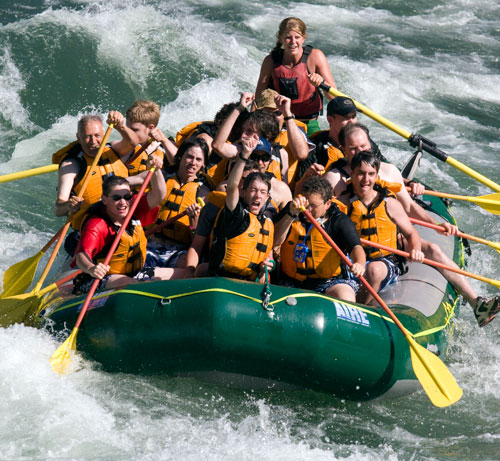 Taking time off for good behavior, Arrowmen run the Big Kahuna on Snake River. |
HERE IT COMES. Big Kahuna. The most aptly named rapid in this frothing section of Wyoming’s Snake River is less than a minute of light paddling away. A bald eagle hovers overhead, slicing between a pair of cliffs and an endless blue horizon in the heart of Big Sky Country. The raft shoots around a corner. The current gathers speed, sweeping toward a giant ledge. The first scream-inducing curlers of Big Kahuna are now dead ahead.
What better time for a little small talk among Order of the Arrow members enjoying a day of recreation during one of the greatest conservation projects in Scouting history?
 Robbie Hirschmann of New Orleans Troop 60 swings his pick, helping prepare a trail in Bridger-Teton National Forest. |
“So where’s everybody from?” the raft’s muscled guide asks the boatload of elite Scouts—a dozen life-jacketed Arrowmen converging from a dozen different corners of the country for this singular purpose.
“El Paso!” someone hollers back
“Upstate New York!” yells another.
“Astatula, Florida!” bellows a third, digging his paddle into the churning river.
“C’mon, boys. Let’s take this thing.”
A moment later, they’re in the spin cycle. The boat dives hard into the rapid’s first hole, soaking half of the elated crew. The raft rises and then nosedives again. Big Kahuna just got bigger.
“Man overboard!”
It’s not a first for this set of rapids this week—a Scout getting more acquainted with the Snake River than planned. Today’s bucked-off passenger is Matthew Schulte, a former chief of Central New Jersey’s Sakuwit Lodge 2. He, along with more than a thousand other OA volunteers, has traveled to Jackson Hole, Wyo., to do something even more historic than shoot down Big Kahuna feet first.
A life buoy is tossed. Seconds later, Schulte is back on board—cold and disoriented but otherwise in good spirits.
“So that was Big Kahuna, huh?” sputters Schulte, catching his breath and grabbing a paddle. He grins, joining in the mirth of his fellow Arrowmen. “I thought this was supposed to be our day off.”
Leaving a legacy
Five national forests. Five weeks. Five thousand OA volunteers registering 280,000 work hours. The value is an estimated $5.6 million in what has been touted as the largest U.S. Forest Service volunteer project ever. In nearly a century of public service, Scouting took on its most ambitious undertaking yet and entered it into the history books last summer during ArrowCorps5.
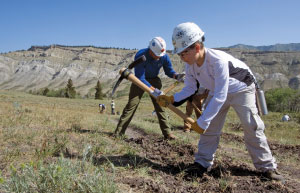 Sweat equity: Tyler Linner from Minnesota Troop 9089 (right) digs working on this ATV trail. |
Years in the making, ArrowCorps5’s epic partnership between the BSA and the Forest Service began auspiciously enough last June in Missouri’s Mark Twain National Forest. More than 500 Arrowmen and support staff conducted a week of wilderness restoration and invasive-species removal in 150 acres of remote backcountry.
Over the next two months, the work projects would move on to Utah’s Manti-La Sal, Virginia’s George Washington and Jefferson, and California’s Shasta-Trinity national forests before ArrowCorps5’s flagship week—at least for the 1,000-plus Arrowmen attending the project’s fifth, final, and largest phase—in western Wyoming’s Bridger-Teton National Forest.
“This was definitely my first choice of the five locations,” says Ben Parker, taking a breather beside a just-built, 40-foot off-road-vehicle closure gate in the heart of Bridger-Teton’s Gros Ventre region.
This mountainous corridor of pristine backcountry with a Teton Range backdrop could pass for a page from an Ansel Adams calendar.
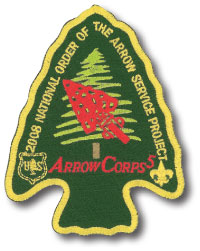 “You don’t get mountains and scenery and meteor showers like this back in Flint,” notes the 18-year-old Eagle Scout from Michigan’s Cuwe Lodge. “It’s just indescribable to be working in a setting like this.”
“You don’t get mountains and scenery and meteor showers like this back in Flint,” notes the 18-year-old Eagle Scout from Michigan’s Cuwe Lodge. “It’s just indescribable to be working in a setting like this.”
Donning hardhats, safety glasses, and work gloves, Parker and a few of his squad members set down a large mattock, a rock bar, and a post-hole digger beside a pile of trail tools that have already gotten plenty of use this morning. Behind them, spread over a mile of mountainside, four busy squads of Arrowmen are covering an ugly track of unauthorized dirt road with sagebrush and grass seed. They are closing it down to off-road vehicles and healing the scar. An hour ago, the large wooden barrier at the base of this hard-packed hill was just one more job on the Forest Service’s endless to-do list. Now it’s up.
“Digging 27 inches into this dirt was worse than cutting into rock,” says Brian Meadows, a 15-year-old Arrowman from Birmingham, Ala. “But with three people working on each post hole, we got it knocked out pretty quick.” He grins. “And, hey, now I can come back here some day with my buddies and point to this thing and say ‘I did that.’”
“Mainly it’s been incredible to work with all of these great people from all over the country,” adds Parker. “And to see just how much we can accomplish in the time we have out here.”
As it turns out, a lot.
Exceeding expectations
By Day 4, the 300 Arrowmen camped out in Gros Ventre have blazed through an entire week’s worth of conservation projects slated for them by the Forest Service. The most grueling job has been the fence removal project: pulling out miles of barbed wire range fences and a 15,000-foot-long, eight-foot-high exclusion fence winding through miles of steep, rugged terrain. For decades the fences have been impacting the natural migration routes of elk, moose, and antelope in one of the nation’s most vital wildlife habitats.
 Chief Scout Executive Robert Mazzuca high-fives David Syfrett of Troop 504 from Destin, Fla., as workers enter History Trailhead from the parking lot. |
“I’d done some fence work before, but nothing quite like this,” says Will Cole, an Eagle Scout from Boaz, Ala., who’d spent his first two days getting plenty of on-the-job training. “We’d be standing 30 feet apart in water up to our ankles in a thicket of willows pulling this stuff off the posts and down the mountain. Everything had to be packed out by horses and mules or by us.”
Bridger-Teton personnel were hoping—if not expecting—to get these fences out within a week. In the first three days, the entire fence removal project has been completed. Miles worth of old fence panels and barbed wire are stacked by the side of the road in neat bales.
“I was keeping my expectations kind of moderate when the Scouts first got here,” says David Wilkinson, a USFS forest technician working with ArrowCorps5 in the Gros Ventre region. “But I’m incredibly inspired by the attitudes and the work ethic they’ve demonstrated. And to pay to come out here and do this—that’s just above and beyond.”
A moment later, a pair of elk shows up near the new closure gate. Like timid foremen, they briefly survey the work and disappear down the hillside into a grove of aspens. It’s almost noon, and the Arrowmen are almost finished with their work here. In a matter of hours, the mountainside scar is nearly gone.
“We’re standing in one of the largest big-game wildlife habitats in the Lower 48,” says Wilkinson. “Every animal that was here 200 years ago still exists: grizzly bears, wolves, mountain lions, bighorn sheep, moose. It’s a huge deal for us, what these guys are doing, and I hope they know that.”
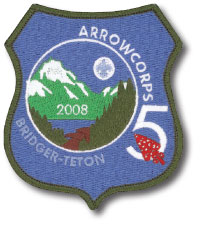 Introducing the Arrow Trail
Introducing the Arrow Trail
Less than a week ago, it was just forest and overgrowth. Stumps, narrow ledges, and lonely red trail markers. But on a bright Thursday morning, 10 miles from Jackson Hole near Teton Pass, the signature trail of ArrowCorps5 is nearly a reality.
The Arrow Trail—five miles of new single-track, winding through flowering meadows and thick groves of towering pine trees at 8,000 feet in the heart of Teton country—is by any measure the flagship project of the summer. An encampment of more than 800 Arrowmen and support staff down the hill at Jackson Hole High School have been commuting up to this area every day to build the OA’s namesake mountain-bike trail from scratch, along with a network of neighboring hiking and equestrian paths in Teton Pass.
Next weekend, the Arrow Trail plans to officially open on schedule with an inaugural ride of 1,000 mountain bikers. But today, it’s still in the making—a well-oiled worksite buzzing with walkie-talkies, sledgehammers, mattocks, McLeods, fire rakes, and hundreds of relentless perfectionists on a joint mission.
“It’s got our name on it, so it better be perfect,” says Bob Dziemian, an Eagle Scout and veteran Arrowman from the North New Jersey Council. He took time off from his audio-engineering job in New York City to join the Arrow Trail effort.
“This is my vacation time, but I’m not complaining at all. It’s just phenomenal to be part of this.”
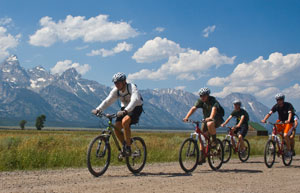 The Tetons' snow-dusted peaks provide spectacular scenery for OA members from Boise, Idaho, Troop 1 on a short recreational mountain-bike ride. |
Dziemian and his unit working along the Arrow Trail’s woodsy midsection are pounding out a few last rocks, filling in some holes, tamping a few more feet of tread, and securing one of the most hard-won pieces of broken trail this week—a 20-foot bridge hewn from a giant fallen tree trunk. Earlier this week, there were some doubts about whether the trail would get finished on time.
“On Monday, when we were training everybody, we weren’t sure,” says Dziemian. “But over the next few days everyone stepped into high gear and busted out so much trail that we’re now actually ahead of schedule. I think that’s pretty remarkable, especially given that this kind of trail work is a new experience for a lot of these guys.”
Up the path, volunteers, young and old, keep turning up along the Arrow Trail—working their tails off and voicing the same sentiments.
“This is a fantastic project for the OA,” says Ronald Morton, a council committee member with Georgia’s Ini-To Lodge and a 48-year veteran of Scouting. He lowers a sledgehammer beside a pile of fill-in rock along the path. “I don’t think they could’ve come up with a better one.”
“I just love giving back and letting people enjoy what we’ve worked on,” says Luke McCurry, a 14-year-old Scout from Bethel Park, Penn., fighting with a patch of deep-rooted grass in a sunny meadow.
“For a parent, this is an awesome experience,” says Michael Marks, a dad from Pittsburgh joining his Eagle Scout son, Robert, on The Arrow Trail. “It’s spiritual, life-changing, and maturing for all the youth who are involved—and they’ll truly be walking away from this with a sense of pride that they’ve done something that’s going to last for decades.”
“There’s definitely a great Forest Service-Boy Scout relationship coming out of this,” concludes Brad Ellis, a sector boss on the trail and OA lodge adviser from Southern Florida. He speaks while finishing a support wall along a narrow curve of the trail. “Especially now that they know what we can do.”
By mid-afternoon tomorrow, the Arrow Trail—all five miles of it—will be officially ready to roll. Hundreds of Arrowmen, exhausted and exhilarated, will head down the highway from Teton Pass one last time—their names and the fruits of their labor indelibly stamped on a job well done.
Counting buffalo
“I think I’d like to work for the Forest service or one of the national parks up here some day,” says Ian Cleghorn, musing aloud on a bus bound for Yellowstone National Park. “I know I’m gonna be back.”
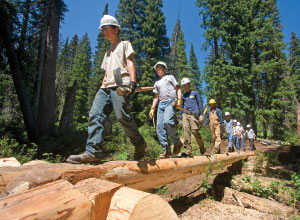 Working Scouts take a walk on the wild side, crossing a log bridge on a portion of the Arrow Trail they'd been constructing. |
After a week of heavy trail work in Bridger-Teton, the 16-year-old Life Scout from Trussville, Ala., is heading home tomorrow, but not before enjoying some Big Sky-style recreation. Choosing between whitewater rafting in the Snake River Canyon, hiking or mountain biking in the Tetons, or bus touring through Yellowstone was its own challenging task. But Yellowstone, 80 miles up the road from ArrowCorps5 headquarters in Jackson Hole, eventually won out.
“I figured I couldn’t come all the way out here without seeing it,” Ian says.
Today will just be a little taste of the nation’s first national park—home to more than half of the world’s hydrothermal features and the largest “super volcano” and alpine lake on the continent.
The tour makes its requisite stops at Old Faithful, a series of steaming and bubbling hotspots, and the all-important photo-op overlooking Yellowstone’s very own Grand Canyon.
Still, it would be fun to see something unexpected. Something to tell everyone about back in El Paso. Or New York. Or Astatula.
On the way out of the park, the first few buffalo appear, meandering on the grassy shoulder of the highway. Then, just down the road, a few more turn up. And a few more. And a few more… Suddenly, just outside the window, a vast open plain is teeming with herds of buffalo. Hundreds of them, charging across an open field on the far side of a glistening river.
The bus stops. Even the driver hasn’t quite seen anything like this before in the park’s lower valley.
“This is as good as it gets, folks.” The bus door swings open—for anyone who wants to get a slightly closer brush with history in the making.
Ian springs out of his seat—along with rows of excited Arrowmen—heading out to seize the moment.
This magical week, it turns out, isn’t quite over yet.
Journalist and author Jordan Rane has contributed features to Outside and Cowboys & Indians magazines, as well as to The Los Angeles Times. He is the author of The Fun Seeker's Los Angeles (Greenline Publications, 2003).
Continuing the LegacyScouting families don’t have to wait for the next ArrowCorps5 to help our public lands. “The point isn’t holding off until someone else plans something for you,” says Tim Beaty, national partnership coordinator of senior, youth, and volunteer Programs for the U.S. Forest Service, “but to take what’s been learned at ArrowCorps5 and figure out how to do it back home.” Here are four steps in the right direction: This one-stop portal within a larger portal (USA Freedom Corps) connects people with public-sector volunteer opportunities. Federal agencies list them by keyword, state, activity, and date range. MEET YOUR LAND MANAGER Successful volunteer projects rely on building relationships with local land managers, whether they’re public or private. Where do you meet them? Start with the blue pages of the phone book, where agency contacts in parks and recreation, agriculture, and even public utilities can help hook up volunteers or point them in the right direction. GET TRAINED In order to find a solution, it’s important to first know what the problem is and how to handle it. That’s exactly what training programs are designed to do: provide an all-important skill set. DON'T STOP CARING Here’s the most important element of all: passion for the well-being of the great outdoors. . |